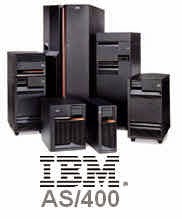IBM AS/400 ONLINE TRAINING
GENERAL AS/400 CONCEPTS
1.
General AS/400 Concepts
a.
Overview of the system.
b.
General awareness of the AS/400 system
c.
Libraries, files and members
d.
Library list concept and related commands.
e.
Command structure and frequently used commands.
2.
ADTS (Application Development Tool Set)
a.
PDM (Program Development Manager)
b.
SEU (Source Entry Utility)
c.
SDA (Screen Design Aid)
d.
RLU (Report Layout Utility)
e.
DFU (Data File Utility)
3.
Query/400
Creation, Executing, accessing data from different member.
4.
DB2/400
a.
Overview of concepts
b.
Externally described files.
c.
Source Physical Files.
d.
Physical files, logical files and join logical files
e.
Field Reference Files
f.
Relational databases and normalization
g.
Runtime considerations
h.
Database Integrity
i.
Database Security : data rights and locks
j.
Triggers
5. CONTROL LANGUAGE (CL/400)
a.
Capabilities of control language programs
b.
Control language program structure & syntax
c.
Features and limitations of control language programs
d.
Scope of control language programs
e.
Control language program coding rules
f.
File handling in CL/400
g.
Handling errors and messages
h.
Handling data areas
i.
Program flow control
j.
Program to program flow control
k.
Overriding file attributes and the scope of variables
l.
Open query file-concepts and use
m. String
Operators
n.
String
Function
6. RPG/400
a.
Introduction to RPG/400, explanation of all
the 7 specifications.
b.
Operation Codes
c.
Subroutines
d.
Constructs in RPG IF, DO, SELRC etc.
e.
Program testing and debugging
f.
Indicators
g.
Tables and Arrays
h.
File access and record manipulation
i.
Control Breaks
j.
Fixed Logic Cycle
k.
Interactive Program
l.
Data Structures
m. String
Manipulation op-codes
n.
Inter-Program communication
o.
Data queue/data area
p.
Sub-files
q.
Load all sub-file
r. Expanding sub-file
s.
Message Sub-file
7. RPG IV
a.
Introduction to RPG IV specifications in brief.
b.
Definition and procedure specifications in brief
c.
New and enhanced op-codes
d.
Built-in functions
e.
Date and Time Data Types
f.
Converting RPG III program to RPG IV program
g.
Procedure and sub-procedures
8. ILE CONCEPTS
a.
Introduction to ILE
b.
Program models & ILE
c.
Module object concept
d.
ILE Program concept
e.
Service program concept
f.
Creating the programs in ILE environment
g.
Binding concept
h.
Calls to programs and procedures
i.
Debugging and ILE program
j.
Activation groups concept
k.
Application of activation groups examples
9. OS/400 COMMANDS
a.
Introduction to Control Language
b.
Command Structure
c.
Types of Commands
d.
Major Command Groups
e.
Command Definition: how to create and run a command
10. SQL/400
a.
SQL command parameters-session attributes
b.
Function keys
c.
ISQL statement prompting
d.
DDL: creating table, view and index
e.
DML: insert, delete, update, select
click here for more details
